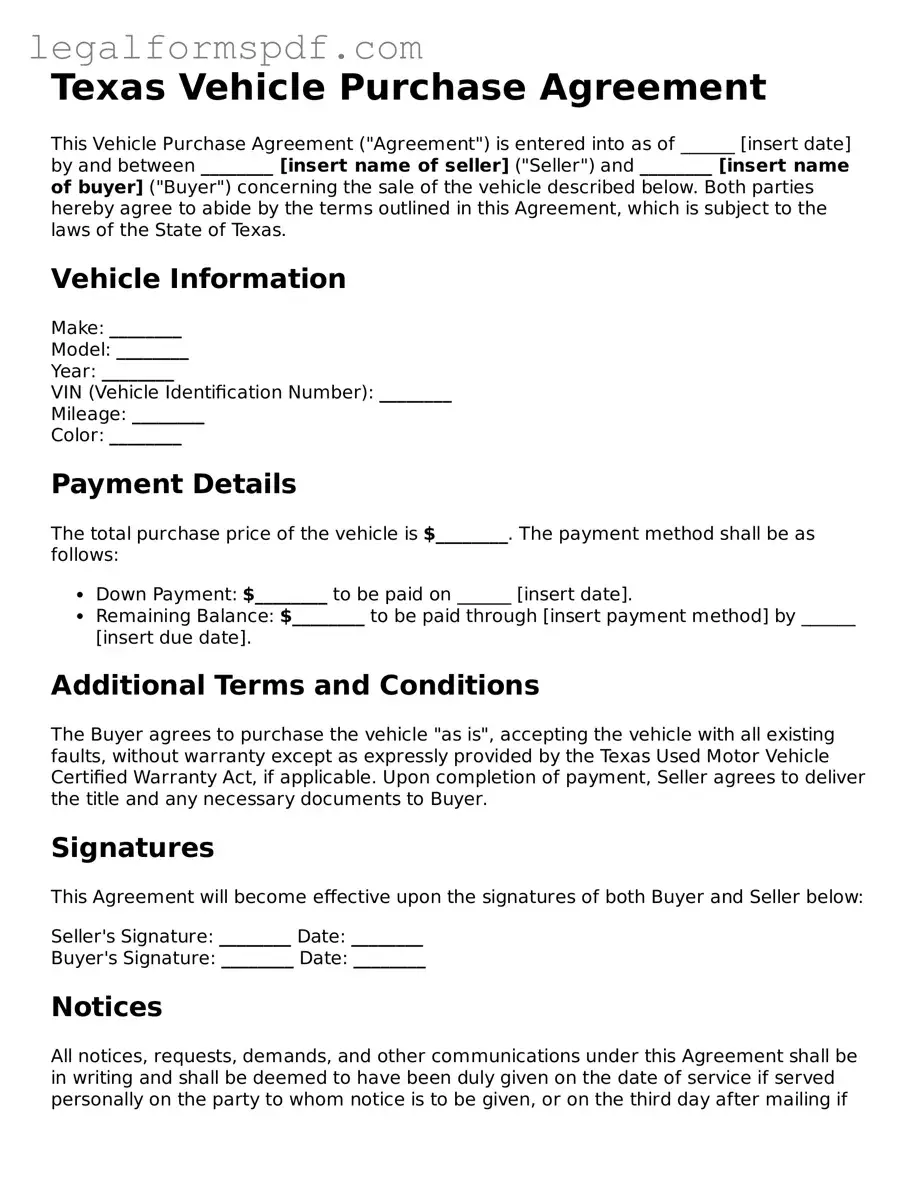The Bill of Sale is closely related to the Texas Vehicle Purchase Agreement, as both serve as proof of a transaction between a buyer and a seller. While the Vehicle Purchase Agreement outlines the terms and conditions of the sale, including warranties and payment details, the Bill of Sale acts as a receipt, confirming the transfer of ownership. It typically lists the make, model, and VIN of the vehicle, the names of the parties involved, and the sale price.
A Purchase and Sale Agreement (PSA) for real estate shares similarities with the Vehicle Purchase Agreement, in that both formalize the conditions under which property is sold. The PSA details the agreement between a buyer and seller for the purchase of real estate, including price, closing conditions, and disclosures, much like the Vehicle Purchase Agreement stipulates for a vehicle sale. However, real estate transactions involve more complex regulations and inspections.
The Loan Agreement is another document with similarities to the Texas Vehicle Purchase Agreement, especially when financing is involved in the purchase. This agreement outlines the terms of a loan provided by a lender to a borrower, including repayment schedule, interest rate, and collateral, which might be the vehicle itself. It ensures both parties are clear about the financial obligations tied to the transaction.
Lease Agreements, while primarily used for renting property, share structural similarities with the Vehicle Purchase Agreement. They both define terms between two parties—the lessee and lessor in a Lease Agreement, and the buyer and seller in a Vehicle Purchase Agreement. Each document specifies conditions such as payment amounts, duration of the agreement, and responsibilities of each party.
Warranty Documents mirror the Vehicle Purchase Agreement in terms of outlining specific guarantees provided by the seller regarding the condition of the vehicle. These documents detail the scope of what is covered by the warranty, including parts and labor, and for how long, providing the buyer with protection against certain defects or issues post-purchase.
The Title Document, essential in the sale of a vehicle, complements the Vehicle Purchase Agreement by evidencing the legal ownership of the vehicle. It specifies the owner's information and vehicle details like make, model, and year. Upon the sale of the vehicle, the title must be transferred to the new owner, formalizing the change in ownership stated in the Vehicle Purchase Agreement.
A Financing Agreement is key when a vehicle purchase involves a loan directly through the dealership or a third party. Similar to the aspects covered in a Loan Agreement, this document outlines the amount financed, interest rate, and repayment terms, and is often linked with the Vehicle Purchase Agreement when the vehicle itself is the collateral for the financing.
The Receipt serves a simpler function but is related to the Vehicle Purchase Agreement in that it provides proof of payment for the transaction. It typically includes the date of sale, amount paid, and a description of the vehicle. Unlike the more comprehensive Vehicle Purchase Agreement, a receipt is a straightforward acknowledgment of the exchange of funds.
An As-Is Sale Agreement, often included within the broader Vehicle Purchase Agreement, specifically states that the vehicle is being sold in its current condition, with all faults known or unknown. This type of agreement relieves the seller from certain liabilities regarding the condition of the vehicle post-sale and informs the buyer of their assumption of risk.
Finally, the Odometer Disclosure Statement, while not an agreement on its own, is usually required in vehicle sales to certify the accuracy of the vehicle's mileage as stated by the seller. This document supports the integrity of the Vehicle Purchase Agreement by ensuring the buyer is aware of the true mileage, which can affect the perceived value and condition of the vehicle.
